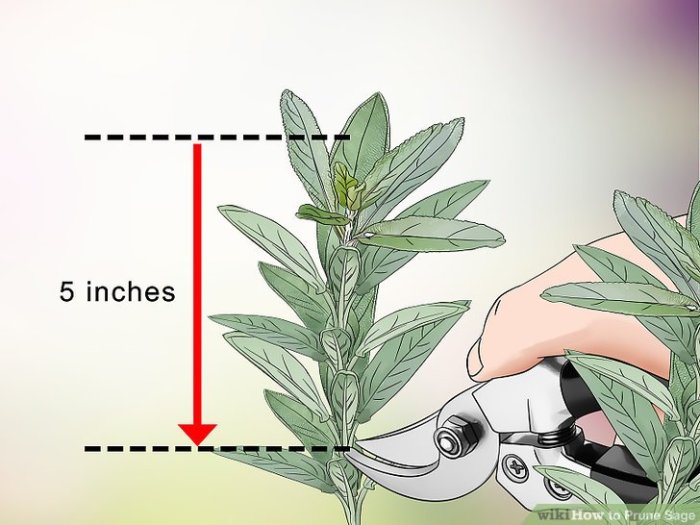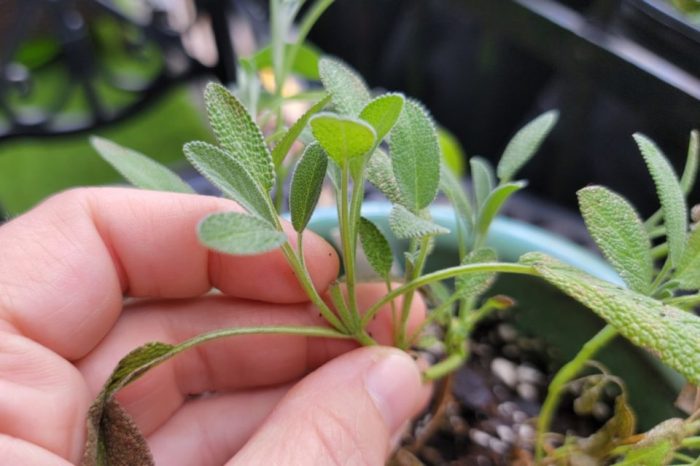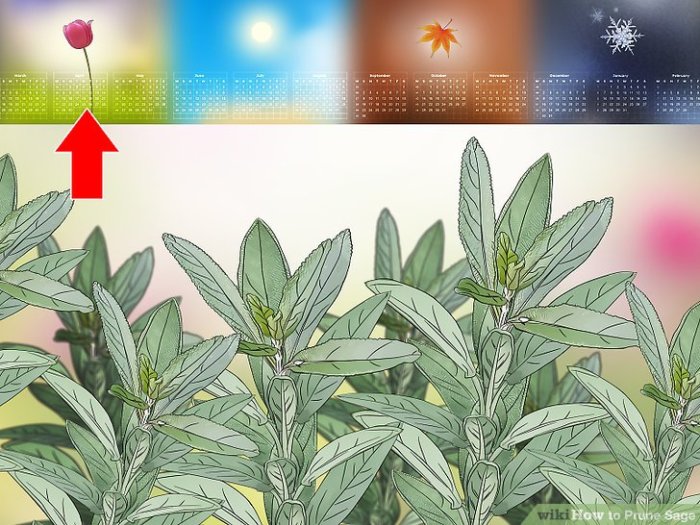How to trim sage plants – Discover the art of trimming sage plants, a practice that not only enhances their appearance but also promotes their health and vitality. From shaping techniques to optimal timing, this guide provides comprehensive insights into the proper care and maintenance of these aromatic herbs.
Whether you’re a seasoned gardener or just starting your herbal journey, this article will equip you with the knowledge and skills to keep your sage plants thriving and looking their best.
Pruning Methods
Trimming sage plants is essential for maintaining their health, promoting growth, and encouraging abundant foliage. There are several methods for trimming sage, each with its own benefits and drawbacks. Here are the most common pruning techniques:
Shearing
Shearing involves cutting back the entire plant to a uniform height, typically between 6 and 12 inches above the ground. This method is ideal for rejuvenating overgrown or neglected sage plants and can help control their size and shape. Shearing should be done in early spring or late fall when the plant is dormant.
Use sharp shears or hedge trimmers to make clean cuts and avoid tearing or damaging the stems.
Pinching
Pinching is a more selective pruning method that involves removing only the tips of the stems, usually by hand or with small scissors. Pinching encourages bushier growth and prevents the plant from becoming leggy. It can also be used to remove spent flowers or damaged leaves.
To trim sage plants, start by removing any dead or diseased leaves. Then, use sharp shears to cut back the stems to about one-third of their original length. This will encourage new growth and help the plant maintain its shape.
If you’re looking for more information on trimming plants, check out our article on how to trim blueberry plants . After trimming, water the sage plant deeply and fertilize it according to the package directions.
Pinching can be done throughout the growing season as needed.
Deadheading
Deadheading involves removing spent flowers to prevent the plant from putting energy into seed production. This encourages continued flowering and promotes a more attractive appearance. Deadheading should be done regularly, especially during the blooming period. Simply remove the spent flowers by cutting the stem back to the next set of leaves.
Timing and Frequency

The optimal time to trim sage plants depends on the purpose of the trimming. For general maintenance and shaping, it’s best to trim sage plants in the spring or early summer, before the plant flowers. This will encourage bushy growth and prevent the plant from becoming leggy.
If you’re trimming sage for culinary purposes, you can trim it throughout the growing season, but avoid trimming it too heavily in the fall or winter, as this can weaken the plant.
The frequency of trimming will depend on the growth habit of the plant and the desired shape. Fast-growing sage plants may need to be trimmed more frequently than slow-growing varieties. To maintain a compact shape, trim the plant regularly to remove any new growth that extends beyond the desired size.
Consequences of Over-Trimming or Under-Trimming
Over-trimming sage plants can weaken the plant and make it more susceptible to pests and diseases. It can also reduce the plant’s ability to produce flowers and seeds. Under-trimming, on the other hand, can lead to a leggy, untidy plant that is less productive.
It’s important to find a balance between over-trimming and under-trimming to maintain a healthy, productive sage plant.
Tools and Equipment: How To Trim Sage Plants
Trimming sage plants requires the right tools to ensure clean cuts and promote healthy growth. Here’s a list of essential equipment and guidance on selecting the right ones.
For precise cuts, sharp shears or scissors are necessary. Choose bypass shears for clean, straight cuts, or anvil shears for tougher stems. Additionally, a sharp knife can be useful for removing larger branches or suckers.
To trim sage plants, simply remove the top few inches of the stems, just above a leaf node. This will encourage the plant to produce new growth and keep it from becoming leggy. Similarly, trimming spider plants involves removing the tips of the plant’s long, trailing stems.
This will encourage the plant to produce new growth and keep it from becoming too unruly. After trimming sage plants, be sure to water them well and fertilize them lightly to help them recover.
Choosing the Right Tools, How to trim sage plants
The choice of tools depends on the trimming method and the size of the sage plant. For light trimming and shaping, handheld shears or scissors are sufficient. For larger plants or more extensive pruning, bypass loppers or hedge trimmers may be necessary.
Importance of Sharp and Clean Tools
Maintaining sharp and clean tools is crucial. Dull tools can crush and tear plant tissues, leaving them vulnerable to disease and pests. Disinfect tools regularly with a 10% bleach solution to prevent the spread of diseases.
Shaping and Aesthetics

Trimming sage plants for shaping and aesthetics involves techniques that enhance their ornamental value and create desired forms. By carefully pruning and shaping, gardeners can achieve balanced and visually appealing sage plants that complement their landscape designs.
Creating Hedges
To create formal hedges, trim sage plants regularly to maintain a dense, uniform shape. Use sharp shears to cut back new growth along the sides and top of the hedge, creating a level surface. Regular trimming encourages dense growth and prevents the hedge from becoming leggy or uneven.
Topiaries
Topiaries are ornamental shapes created by trimming sage plants into various forms, such as balls, spirals, or animals. To create topiaries, start with a young, healthy sage plant and gradually shape it over time by selectively pruning and trimming. Patience and precision are key to achieving intricate and visually striking topiaries.
To keep sage plants in good shape, it’s important to trim them regularly. This encourages new growth and helps prevent the plant from becoming leggy. To trim sage, simply use sharp shears to cut back the stems by about one-third.
You can also trim liriope plants in a similar way. Click here to learn more about how to trim liriope plants. When trimming sage, be sure to remove any dead or diseased leaves or stems. This will help keep the plant healthy and looking its best.
Compact Bushes
For a compact and bushy appearance, trim sage plants back by about one-third to one-half their size after flowering. This encourages new growth from the base of the plant, resulting in a fuller and more compact shape. Regular trimming also helps prevent the plant from becoming leggy or overgrown.
Health and Maintenance

Trimming sage plants not only enhances their aesthetic appeal but also promotes their overall health and longevity. Regular trimming removes diseased or damaged foliage, preventing the spread of infections and pests. It also encourages new growth, improves air circulation, and allows sunlight to penetrate the plant’s interior, leading to increased vigor and productivity.
Signs of Disease or Pests
- Discolored or wilted leaves
- Yellowing or browning of foliage
- Holes or tears in leaves
li>Presence of insects or eggs on the plant
Early detection of disease or pests is crucial for effective treatment and prevention of further damage. Prompt trimming of affected foliage is essential to contain the spread of infection or infestation.
Final Thoughts

Mastering the art of trimming sage plants empowers you to shape their growth, enhance their health, and maximize their ornamental value. By following the guidance Artikeld in this article, you can ensure that your sage plants flourish as beautiful and productive additions to your garden.
FAQ Guide
When is the best time to trim sage plants?
The optimal time for trimming sage plants varies depending on the desired outcome. For general maintenance and shaping, early spring or fall is recommended. To encourage new growth and bushier plants, trim lightly throughout the growing season.
How often should I trim my sage plants?
The frequency of trimming depends on the growth rate and desired shape of your sage plants. Generally, light trimming every few weeks is sufficient for maintaining a healthy and compact form.
Can I trim diseased or damaged sage leaves?
Yes, it is essential to remove diseased or damaged foliage promptly to prevent the spread of infection. Cut away affected leaves at their base, ensuring you do not leave any remnants that could harbor pathogens.